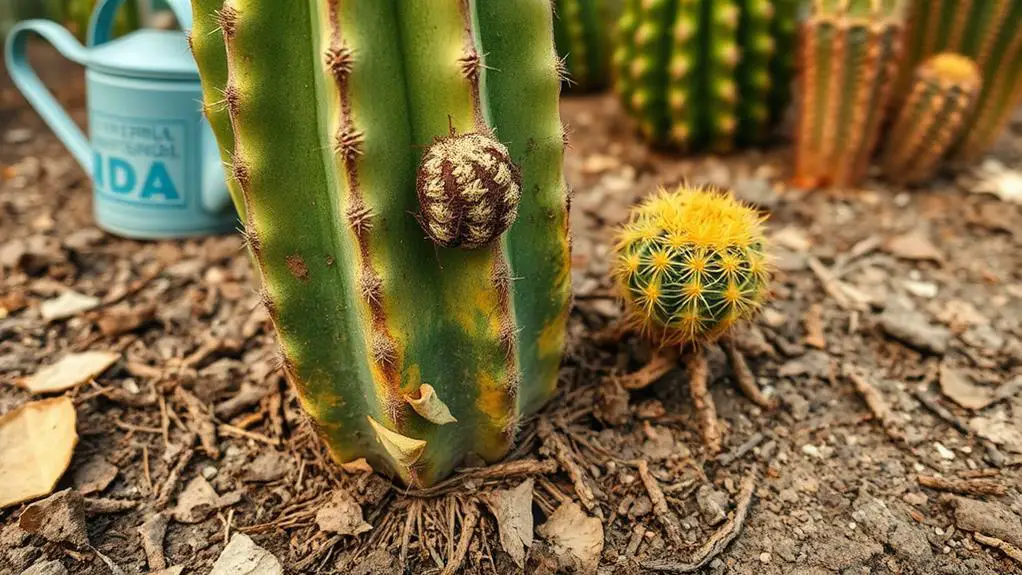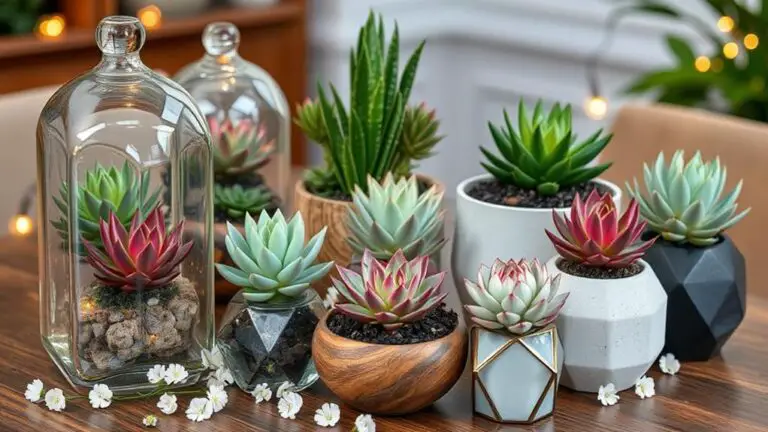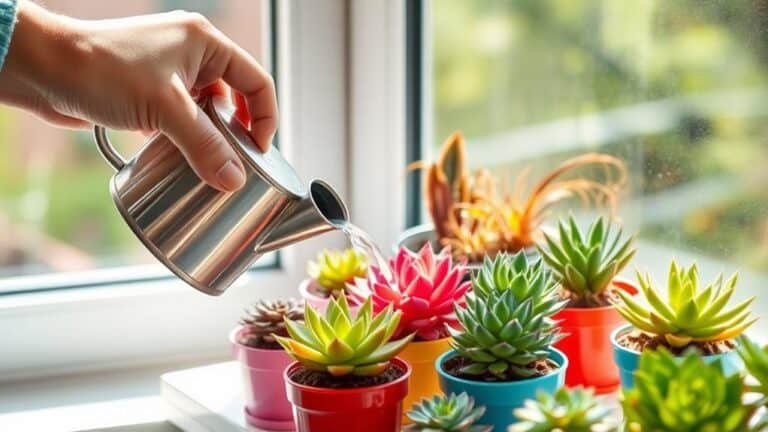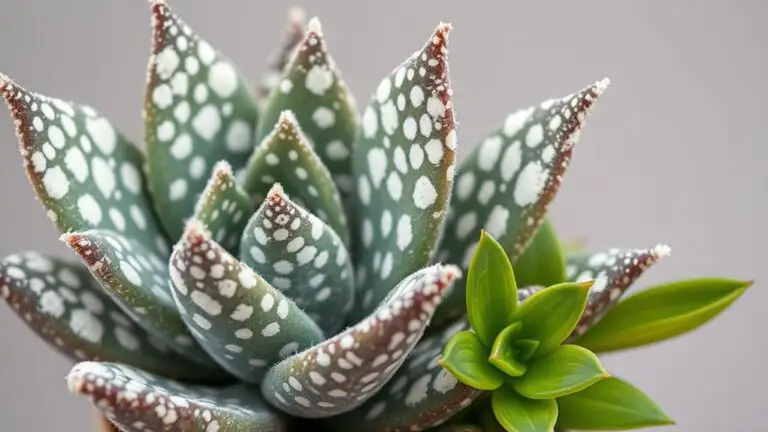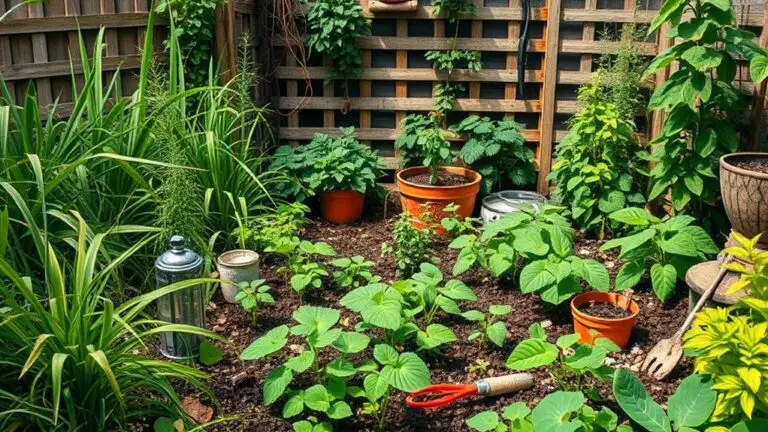9 Common Problems When Growing Cacti and How to Fix Them
Growing cacti isn't always as straightforward as it seems, and you might encounter a range of issues that can hinder their growth. Overwatering, for instance, can cause root rot, while underwatering can lead to dehydration. Poor soil quality, insufficient lighting, and excessive sunlight can also create problems. And let's not forget about high humidity, cold, wet conditions, and pesky pest infestations like mealybugs and spider mites. Each of these problems requires specific solutions to guarantee your cacti thrive. Curious about how to address these common issues effectively? Let's explore practical strategies to keep your cacti healthy and vibrant.
Overwatering
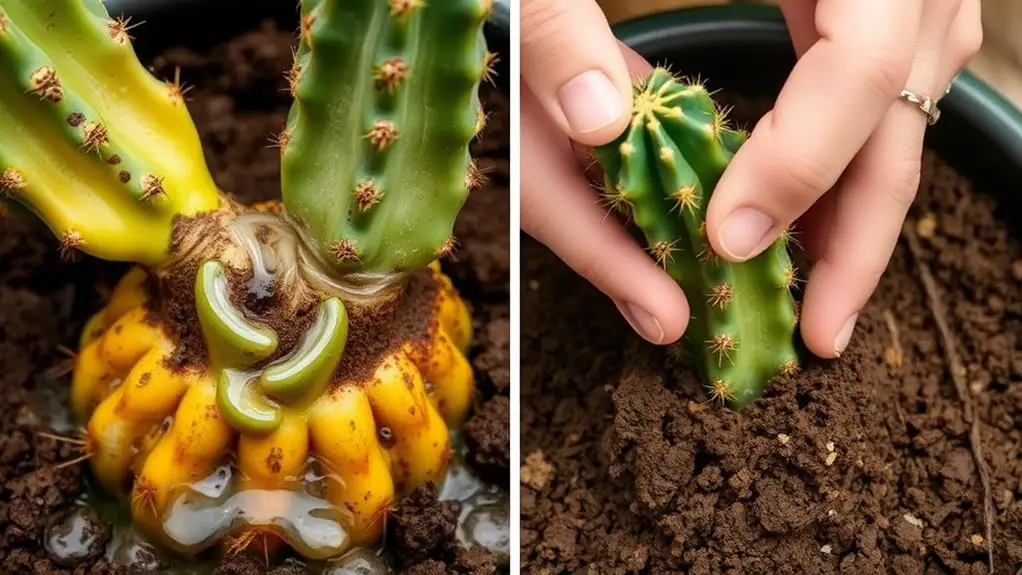
Overwatering is, by far, one of the most common problems gardeners face when growing cacti. When you give your cactus too much water, it can lead to root rot. This happens because excess moisture deprives the roots of the oxygen they need. You might notice symptoms like mushy stems, yellowing leaves, or a general lack of growth. These signs indicate that your cactus is stressed and more vulnerable to pests and diseases.
To prevent overwatering, let the topsoil dry out completely before watering again. The frequency will depend on your climate and seasonal changes. Using pots with drainage holes is vital as it helps excess water escape.
Also, choose a well-draining soil mix, such as a combination of potting soil, sand, and perlite. This mix guarantees water doesn't stay around the roots for too long.
Regularly monitor your cactus for signs of distress. Look out for blackened stems or a foul smell from the soil. Catching these symptoms early can help you take corrective measures quickly.
Underwatering
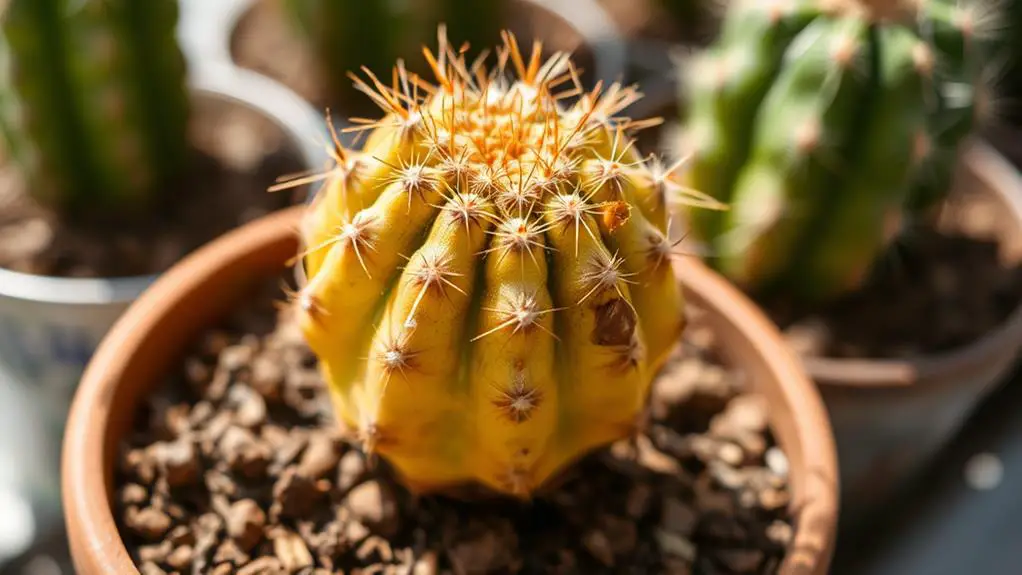
Underwatering, while less common than overwatering, can still pose significant problems for your cacti. When your cactus doesn't get enough water, it shows visible signs like limp, wrinkled stems and yellowing or browning. These signs indicate your plant isn't getting the hydration it needs to stay healthy.
Cacti are designed to store water, but if they go too long without it, they can become dehydrated and stressed. Regular monitoring is essential. You might notice that your cactus isn't growing as well as it should, which can affect its overall look and strength.
Signs of underwatering often start from the lower leaves, where you'll see puckering and shriveling. These are clear indicators that your cactus needs water immediately.
To prevent underwatering, follow these steps:
- Increase watering frequency during the spring as temperatures rise.
- Reduce watering in autumn when growth slows down.
- Check the soil regularly to verify it's not completely dry.
- Observe your plant for any signs of distress, like wrinkling or yellowing.
Poor Soil Quality

While guaranteeing your cactus gets the right amount of water is vital, the soil it grows in is equally important. Poor soil quality can lead to a host of problems, from root rot to stunted growth. Cacti need well-draining soil to thrive. If you use regular potting soil, it can retain too much moisture, putting your cactus at risk for root rot.
To avoid these issues, create a proper cactus mix. Ideally, this should be 30% potting soil and 70% materials like perlite, sand, or gravel. This combination enhances drainage and allows for better aeration, which is essential for healthy root systems.
Heavy or compacted soil can suffocate your cactus roots, preventing them from getting the oxygen they need.
Don't forget about the nutrient profile of the soil. Nutrient-poor soil can stunt your cactus's growth. Make sure to provide a balanced mix tailored to your cactus species.
Repotting every couple of years with fresh cactus mix helps refresh soil nutrients and guarantees proper drainage. This simple step can make a big difference in promoting healthier growth for your cactus.
Insufficient Lighting
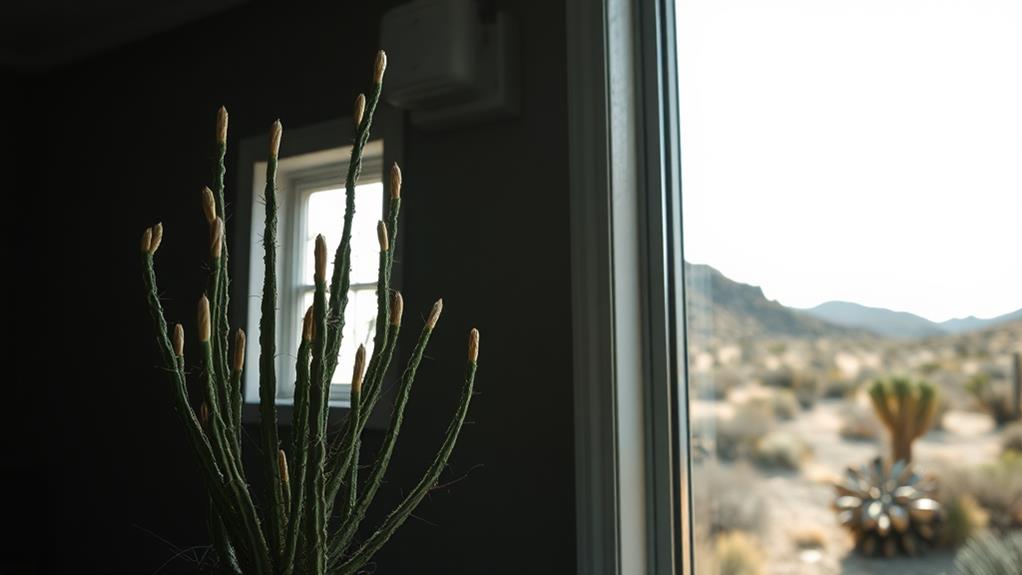
Ensuring your cacti get enough light is essential for their health and growth. Cacti need at least 6-8 hours of bright sunlight daily. Without sufficient light, your cacti may suffer from etiolation, where they develop elongated, weak stems as they stretch toward the light source. This condition makes them look unhealthy and less appealing.
Here are some telltale signs that your cacti are suffering from insufficient light:
- Etiolation: The stems grow long and thin, indicating they need more light.
- Discoloration: Deep green cacti may fade to pale hues, showing they're not getting enough sunlight.
- Leaning: Your cacti might start leaning dramatically toward the light source.
- Stunted Growth: A lack of bright sunlight can cause your cacti to grow slowly or stop growing altogether.
For ideal cactus care, place your cacti near a south-facing window, where they can soak up the sun.
If you're moving them outdoors, do it gradually to prevent stress or damage. Monitor for signs of sunburn like brown spots and calloused flesh.
Excessive Sunlight

When your cactus gets too much direct sunlight, especially during the hottest parts of the day, it can suffer from sunburn.
You'll notice browning or calloused spots that feel corky, and unfortunately, these damaged areas can't heal and might need to be pruned.
To avoid this, try providing some shade during peak sunlight hours and gradually adjust your cactus to stronger light if it's been indoors.
Signs of Sunburn
Cacti exposed to too much direct sunlight can suffer from sunburn, which manifests as brown spots, corky scabs, and callused areas on the plant's surface.
If you notice these symptoms, it means your cactus is struggling with excessive sunlight. The sunburn usually appears on the side of the cactus facing the sun, showing it can't handle the intense light.
Unfortunately, once a cactus gets sunburned, those areas can't heal and may require pruning to remove the damaged parts.
To help your cactus recover and thrive, follow these steps:
- Prune: Carefully cut away the sunburned sections to encourage new, healthy growth.
- Acclimate: Gradually introduce your cactus to more sunlight, especially if it's been indoors. This helps it adjust without getting burned.
- Shade: Provide shade during the hottest parts of the day, usually around noon, to protect it from harsh sunlight.
- Monitor: Keep an eye on your cactus regularly for any signs of sunburn, and adjust its exposure accordingly.
Preventing Sun Damage
Preventing sun damage in cacti involves a few strategic steps to guarantee they get the right amount of light without getting scorched. Cacti love bright sunlight, but too much can cause sunburn, making them brown or calloused. To avoid this, you should provide morning and afternoon sunlight but give them some shade during midday, especially when the sun's most intense.
When you move indoor cacti outside, do it gradually. This process, called acclimatization, helps them adjust to the intense sunlight without getting shocked. Start by placing them in a shaded spot and slowly increase their exposure to direct light over several days.
Setting your cacti near south-facing windows is another great way to ascertain they get adequate sunlight while still being protected from excessive brightness. These windows let in lots of light but not the harsh midday sun that can cause sunburn.
You can also use other plants or structures to create some shade. This way, your cacti get the bright sunlight they need for healthy growth without the risk of sunburn.
High Humidity
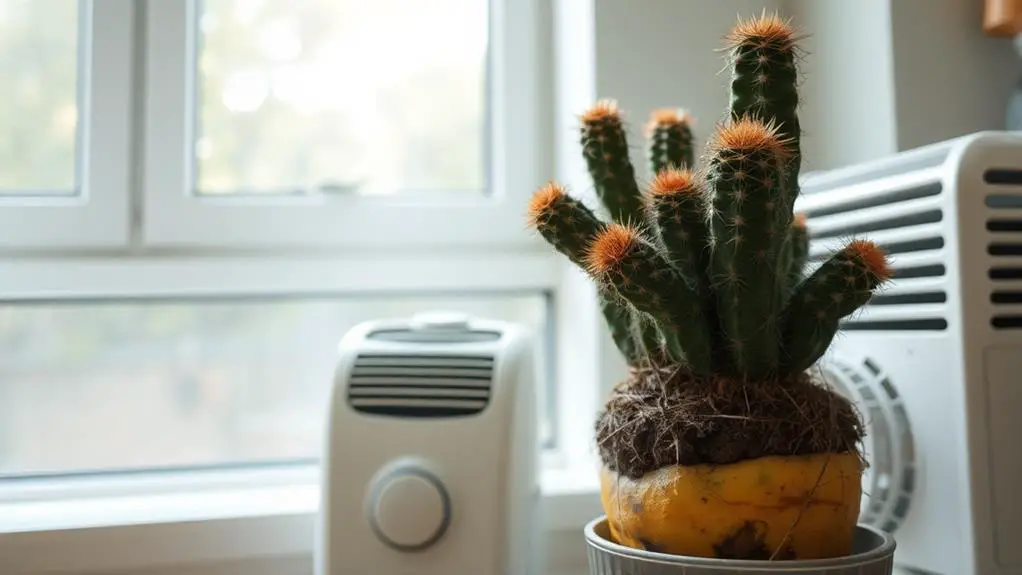
High humidity can be a real challenge when growing cacti, as it often leads to problems like corky scab and fungal infections.
To keep your cacti healthy, you need to monitor and reduce indoor moisture, ideally keeping humidity below 50%.
Make sure to place your cacti in well-ventilated areas and consider using a dehumidifier if needed.
Causes of High Humidity
In environments where humidity levels soar, cacti face significant challenges that can jeopardize their health. High humidity and excess moisture create ideal conditions for fungal infections, which can lead to rot and weaken your cactus.
These plants thrive in arid conditions, so humidity levels above 50% can stress them and hinder their growth.
To better understand the causes of high humidity around your cacti, consider these factors:
- Poor Ventilation: Without proper ventilation, excess moisture gets trapped, raising humidity levels. Guarantee good airflow by spacing plants adequately.
- Overcrowding: Placing too many plants close together can impede airflow, creating a humid environment. Spread them out to lower humidity.
- Indoor Moisture Sources: Avoid placing cacti near radiators, humidifiers, or other moisture sources. These can increase ambient humidity, stressing your plants.
- Weather Conditions: In naturally humid climates, controlling indoor humidity is vital. Use dehumidifiers or ventilation fans to maintain low humidity levels.
Being aware of these factors can help you create a healthier environment for your cacti.
Reducing Indoor Moisture
Reducing indoor moisture is essential for maintaining healthy cacti, especially in naturally humid climates. High humidity levels can cause cactus corky scab, leading to fungal infections and rot. To keep your cacti thriving, aim to lower the humidity in your home.
First, place your cacti in well-ventilated areas to improve air circulation. This helps reduce moisture buildup around the plants. Avoid overcrowding your cacti, as proper spacing enhances airflow and further reduces humidity levels.
Remember, cacti love arid environments, so give them space to breathe.
Using a dehumidifier can also make a big difference. Dehumidifiers effectively lower indoor humidity, creating a more suitable environment for your cacti. It's a simple solution that can save your plants from unnecessary stress.
Regularly monitor the humidity levels in your home with a hygrometer. Aim for a range of 30-50% for ideal cactus health. Keeping an eye on these levels will guarantee your cacti remain in their preferred dry conditions.
Cold and Wet Conditions
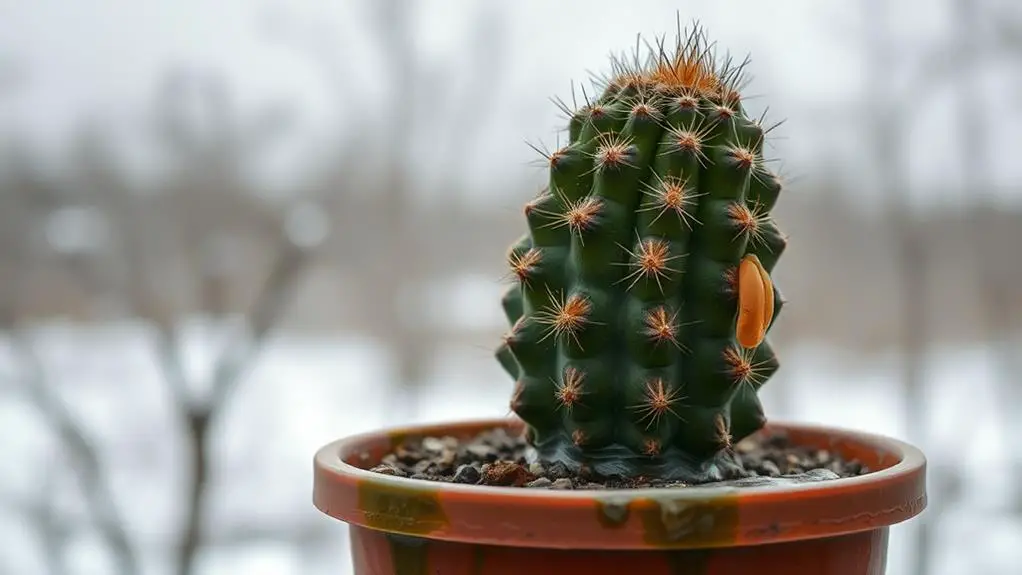
Cacti often struggle in cold and wet conditions, making it vital to understand how to protect them during such periods. Cold temperatures and excess moisture can lead to root rot, especially when drainage and ventilation are inadequate.
Here's how you can safeguard your cacti:
- Monitor Humidity Levels: High humidity combined with low temperatures can exacerbate root rot. Make sure to keep indoor environments dry, especially during winter.
- Guarantee Proper Drainage: Use pots with good drainage to prevent water from pooling around the roots. This helps maintain oxygen access and reduces the risk of root rot.
- Provide Shelter from Cold: Position your cacti in sheltered areas to protect them from frost. Temperatures below 10°C (50°F) can cause significant damage.
- Improve Ventilation: Ensure proper airflow around your cacti. Cold air holds less moisture, so good ventilation helps keep the environment dry and reduces fungal infection risks.
Pest Infestations

Pest infestations pose a significant threat to the health of your cacti, often undermining their growth and vigor. Common pests like mealybugs, spider mites, and scale insects can cause serious damage.
You'll notice symptoms such as wrinkled and shriveled leaves, sticky residue, and webbing or small brown dots on new growth.
To protect your cacti, regular inspections are essential. Check your plants often to catch any pest problems early. If you find pests, you can start by washing them off with a strong stream of water. Yellow sticky traps are also useful for catching flying pests.
Integrated pest management is your best strategy. This means using several methods together to control pests. For example, quarantining new plants before adding them to your collection can prevent pests from spreading.
If you need to use chemicals, insecticidal soaps, neem oil, and systemic insecticides like imidacloprid can be effective. Always follow the instructions on the label and test on a small area first to guarantee safety.
Seasonal Care Adjustments
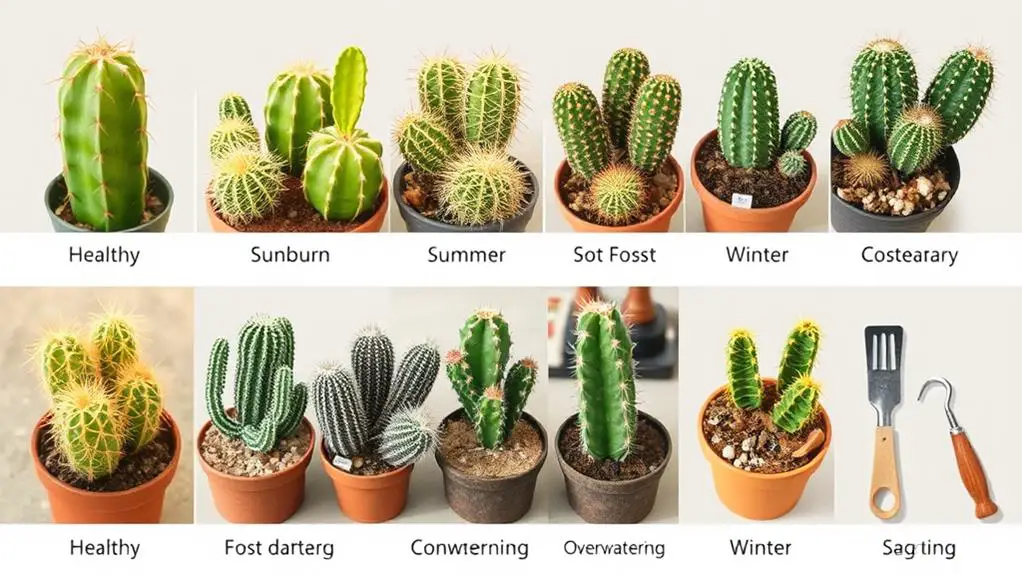
Caring for your cacti involves making important seasonal adjustments to guarantee they thrive all year round.
During the winter months, keep your cacti in temperatures around 10°C, away from radiators or heaters. This helps prevent cold stress and excessive moisture retention, which can lead to root rot. Reduce watering to avoid over-saturation, as cacti need less water when they're dormant.
In spring, as temperatures rise, gradually increase your watering schedule to support active growth. Make sure the soil composition allows for proper drainage, so it dries out between waterings. By paying attention to your cactus's needs, you can prevent over-watering and root issues.
Summer means more sunlight. Your cacti need full sun for 6-8 hours each day. However, watch out for signs of sunburn. If you notice any, adjust their positioning to provide some midday shade. This keeps them healthy and prevents damage from too much direct sunlight.
As autumn approaches, prepare your cacti for dormancy:
- Reduce watering frequency.
- Place them in a dry location.
- Monitor humidity levels.
- Adjust care routines based on seasonal monitoring.
Regularly check environmental conditions to make necessary adjustments, ensuring your cacti stay vibrant and strong through every season.
Frequently Asked Questions
How Do You Repair a Cactus?
To repair a cactus, remove it from its pot, trim any damaged roots, and repot it in fresh, well-draining soil. Increase watering if it's dehydrated, and gradually acclimate it to brighter light if needed. Prune damaged sections.
How Can I Make My Cactus Grow Better?
Make certain your cactus gets well-draining soil, adequate sunlight, and proper watering. Check for pests regularly and adjust care based on seasonal needs. Healthy growth comes from monitoring conditions and making necessary adjustments to your cactus's environment.
How Do You Fix a Dying Cactus?
First, check for overwatering and let the soil dry out. Use well-draining soil, guarantee ample sunlight, inspect for pests, and treat if necessary. Prune dead parts to promote new growth and improve airflow.
What Does Cactus Disease Look Like?
Cactus disease often shows as yellowing or browning spots, mushy stems, or black roots. You might also see sticky residue, webbing, or cottony masses. These symptoms indicate issues like overwatering, fungal infections, or pests.
Conclusion
By keeping an eye on these common cactus problems and following our tips, you'll set your plants up for success. Remember, it's all about balance—water just right, provide suitable light, and use quality soil. Don't forget to check for pests and adjust care with the seasons. You've got this! With a little attention and care, your cacti will thrive, adding beauty and charm to your space. Happy gardening!

